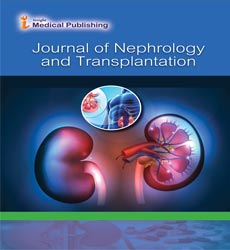Brief Note on Classification of vasculitis
James Murray*
Department of Medicine, RJK University, Illinois, United States
- *Corresponding Author:
- James Murray
Department of Medicine,
RJK University,
Illinois,
United States
E-mail: JamesMurray@gmail.com
Received Date: October 04, 2021; Accepted Date: October11, 2021; Published Date: October 25, 2021
Citation: Murray J (2021) Brief Note on Classification of Vasculities. J Nephrol Transplant Vol.5 No.4:003.
Abstract
The classification for some vasculitis has recently changed. These include granulomatosis with polyangiitis GPA, formerly known as Wegener's granulomatosis and eosinophilic granulomatosis with polyangiitis ofrmerly known as Churg-Strauss syndrome. EGPA and vasculitis formerly known as a Henoch-Schoenlein purpura.
Keywords
Polyangiitis; Erythematosus; Fibrinoid necrosis
Introduction
Vasculities include granulomatosis with polyangiitis, formerly known as Wegener's granulomatosis and eosinophilic granulomatosis with polyangiitis formerly known as Churg- Strauss syndrome. EGPA and vasculitis formerly Henoch- Schoenlein purpura groups that can occur independently of each other such as GPA (Wegener) and Microscopic. Polyangiitis have been established such as rheumatoid arthritis and systemic lupus erythematosus. It can occur as a difficulty of the systemic lupus [1].
The term "vasculitis" means that "flame" or inflammation is directed at the vessel wall, and the result of such inflammation is damage and destruction of the vessel wall, which is histologically considered fibrinoid necrosis [2]. Therefore, the term "necrotic vasculitis" has often been used in the past. Vasculitis can be confined to a single organ or vascular bed and is relatively benign, but more mutual.
The anterior disturbs part of the vessel wall, but can cause aneurysms and ruptures, and segmental lesions which affect the entire circumference and occur more often, but distally it leads to stenosis or obstruction with infarction [3]. The outcome of vasculitis depends on the location, size, and number of blood vessels affected. These pathological processes explain why severe bleeding and significant organ infarction are the most important consequences and life-threatening complications of systemic vasculitis. When only very small blood vessels (capillaries, venules) are affected, as in some small vasculitis, the most commonly affected organ is the skin, which is a sufficient number of blood vessels. Causes problems only when is involved if tissue blood flow is impaired or if there is a severe inflammatory response associated with it; especially if the kidneys are involved.
Classification
The classification of vasculitis has been a controversial area for many years, and certain classification criteria have only recently been introduced. The most widely used classification system reflects the association between predominant vessel size and Anti-Neutrophil Cytoplasmic Antibody (ANCA) [4]. This classification system also broadly reflects therapeutic approaches applied to different groups. Small vessel groups respond well to immunosuppression by cyclophosphamide and corticosteroids, while macrovascular groups require medium to high doses of steroids, and small vessel groups sometimes require low doses of corticosteroids. In addition, the small mean vascular group is most likely to develop glomerulonephritis and renal failure, is associated with ANCA, and is pathologically contrasted with the small vascular group, which is often associated with immune complexes. This gave genetic to the concept of ANCA Associated Vasculitis (AAV) [5]. This reflects the idea of granulomatosis with polyangiitis (Wegener), microscopic polyangiitis.
In general, the cause of vasculitis is unfamiliar. An important occurrence is the interaction of environmental factors with a genetic predisposition. Currently, somewhat is known about genetic factors. HLA types are important risk factors for various types of vasculitis. Infections have long been considered an important trigger, but with the exception of some specific cases, no causal link could be shown (eg, HBV and PAN, HCV and cryoglobulinemia). Although many drugs are involved, hydralazine and propylthiouracil are clearly associated with the development of vasculitis [6].
Conclusion
Primary systemic vasculitis can affect the vascular system of any organ system. Depending on the caliber of the affected blood vessels and organs, vasculitis can manifest itself in different forms in different disciplines. There are no diagnostic criteria or pathological tests for systemic vasculitis. The use of classification criteria in clinical practice is disappointing and should be avoided. Histopathology can be diagnostic, but there are varying diagnostic yields depending on the skill of the operator, the sampling method, and the organ being biopsied.
Conflict of Interest
The authors declare that there was no conflict of interests.
References
- Ojewole GS, Okoye FC, Ukoha OA (2015) A multilevel clinical case definition for surveillance and epidemiological studies. kidney international reports. Nephron Clin Pract 4(7): 462-467.
- Wafar RJ, Yakubu B, Lalabe BC (2017) Beginning of a journey:Unraveling the mystery of chronic kidney disease of unknown aetiology (CKDu) in Sri Lanka. Globalization and Health. J Clin Nephrol 5(3): 1-8.
- Oboh G, Akindahunsi AA, Oshodi AA (2002) Prospective biopsy based study of ckd of unknown etiology in Sri Lanka. J Clin Nephrol 15(5): 617-622.
- John K (2012) The kidneys in paroxysmal nocturnal hemoglobinuria J Blood 55(1): 111-121.
- Abeke FO, Ogundipe SO, Dafwang II, Sekoni AA, Abu A (2008) Deep sequencing reveals stepwise mutation acquisition in paroxysmal nocturnal hemoglobinuria. J Clin Invest 35(2):217-223.
- Joseph AM (1982) Abnormal expression and mutation of the RBPJ gene may be involved in CD59(-) clonal proliferation in paroxysmal nocturnal hemoglobinuria. J Exp Ther Med 30(1): 1-199.
Open Access Journals
- Aquaculture & Veterinary Science
- Chemistry & Chemical Sciences
- Clinical Sciences
- Engineering
- General Science
- Genetics & Molecular Biology
- Health Care & Nursing
- Immunology & Microbiology
- Materials Science
- Mathematics & Physics
- Medical Sciences
- Neurology & Psychiatry
- Oncology & Cancer Science
- Pharmaceutical Sciences
